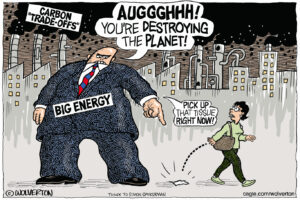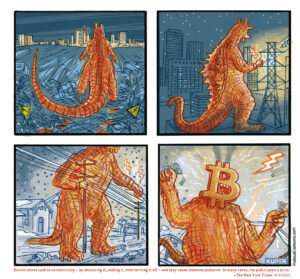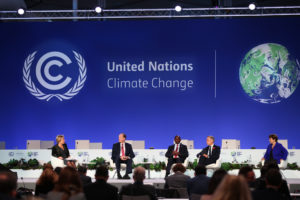Streaming Video Drives Up Global CO2 Emissions
Watching your favorite streamed TV series may seem harmless, but the electricity consumed by the growing demand for video is leaving a hefty carbon footprint. Facebook’s data center in Prineville, Ore. (Tom Raftery / Flickr via Wikimedia Commons)
Facebook’s data center in Prineville, Ore. (Tom Raftery / Flickr via Wikimedia Commons)
By Richard Sadler / Climate News Network
LONDON — The internet is fast becoming a major source of global carbon emissions — and the main cause is video demand, the increasing popularity of “real time” streamed video content.
Video streaming to internet-enabled TVs, game consoles and mobile devices already accounts for more than 60% of all data traffic — and the latest forecasts suggest this will rise to more than 80% by 2020.
Increasingly, viewers across the world are watching films and TV series in real time through subscriptions to Netflix or Amazon, while social media platforms such as Facebook and Twitter are offering more and more streamed video content for free.
This is driving a dizzying increase in the amount of information that needs to be stored and transmitted by power-hungry data centres. Up until 2003 the world had accumulated a total of five exabytes — five billion gigabytes — of stored digital content. By 2015 that amount was being consumed every two days, as annual consumption reached 870 exabytes.
As more video is streamed and more of the world’s population goes online, annual data traffic is forecast to reach 2,300 exabytes by 2019.
Pressure for renewables
The IT sector already consumes around 7% of electricity worldwide, and as data traffic rises, demand from data centres alone could reach 13% of global electricity consumption by 2030.
Now leading video content providers are coming under increasing pressure to show what proportion of their power derives from fossil fuels.
A recent report by Greenpeace USA acknowledges that social media platform Facebook has made significant progress towards its target for 100% of its electricity to come from renewables, following support from millions of its users for Greenpeace’s 2011 “Unfriend coal” campaign. Google and Apple receive praise for progress towards similar commitments made in 2012.
However, major providers of video streaming content including Netflix, Amazon Prime and Hulu are criticised for sourcing more than half of their energy from coal or natural gas.
“The dramatic increase in the number of data centres … dominated by utilities that have little to no renewable energy is driving a similarly dramatic increase in the consumption of coal and natural gas”
Cloud computing market leader Amazon Web Services is credited for taking important steps towards renewables but censured for lack of transparency and heavy reliance on new data centres in the state of Virginia powered mainly by fossil fuels.
Elsewhere the lack of access to renewable energy from monopoly utilities in East Asia is seen as a major obstacle towards creating a renewably-powered internet in the region.
The report concludes: “The dramatic increase in the number of data centres … dominated by utilities that have little to no renewable energy is driving a similarly dramatic increase in the consumption of coal and natural gas.”
Attempting to express the effect of increasing internet traffic in terms of emissions is fraught with difficulty, but one study, published in the journal Environmental Research Letters, has calculated that in 2011 Americans streamed 3.2 billion hours of video.
This would have consumed 25 petajoules of energy (estimated at about the annual consumption of 175,000 US households), resulting in 1.3 billion kilograms of CO2 emissions.
Efficiency limits
The lead author, Arman Shehabi, a research scientist at Lawrence Berkeley National Laboratory in California, said the IT sector had so far managed to offset its soaring electricity needs by designing more energy-efficient data centres. But there was a limit to how far energy efficiency could go.
“The growth in video streaming is enormous just based on the size of the companies that are providing these services — but they are still reaching only a small part of the global population and we can imagine that’s going to just keep increasing,” he said.
“You’re still going to have this growth of more and more servers needed. We’ve seen some good efficiency measures but we’re getting close to the end of that — we can’t go out much further — and with video streaming there’s no end in sight.”
He added that another major driver of future growth in data traffic would be the Internet of Things — remote digital sensors, devices and driverless cars connected to the internet.
Richard Sadler, a former BBC environment correspondent, is a freelance environment and science journalist. He has written for various UK newspapers, including the Guardian, Sunday Times and Ecologist.
Your support matters…Independent journalism is under threat and overshadowed by heavily funded mainstream media.
You can help level the playing field. Become a member.
Your tax-deductible contribution keeps us digging beneath the headlines to give you thought-provoking, investigative reporting and analysis that unearths what's really happening- without compromise.
Give today to support our courageous, independent journalists.






You need to be a supporter to comment.
There are currently no responses to this article.
Be the first to respond.